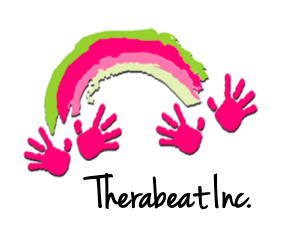For our friends with hearing loss (mild-severe) there is often a misconception about their ability to experience music and to become musicians. Music Therapy is an effective mode of therapy for children with varying degrees of hearing impairments--especially in the areas of speech & language development, cognitive development, social/emotional development, and listening skills. Team Therabeat had the opportunity to present to the Georgia Bell Event at Atlanta Speech School about this topic, so we would like to share a little bit about our presentation here as well!
Research shows that children with hearing impairments share or surpass children without hearing impairments in rhythmic competency (Gfeller, 2016). This is due to the way we “hear” music. In the absence of normal hearing, people may experience music through vibrotactile input via percussive instruments. Children may also rely on visual cueing via therapist/educator demonstrating rhythmic patterns. A therapist or music educator should always be aware of how each individually child experiences music. Each child with hearing impairments has varying degrees of ability to perceive pitches, varying ways of hearing music, and has varying degrees of perception of music. Hearing aids and cochlear implants are formatted for speech sounds, not musical pitches. Therefore, a music therapist should be aware of each child’s preference for timbres and choose instruments accordingly.
Once a therapist knows what kind of musical interventions will work best for the child (or group of children), the following are goal areas that are addressed. These goal areas are based on clinical practice, and peer-review/evidence-based research for music therapy with children with. pre- or per- lingual hearing loss.
· Language Development: increase of vocabulary, increase of spontaneous speech, increase of sophisticated language structures such as metaphors/figures of speech, and pragmatics
· Speech Production: increase vocalizations, increase speech prosody,
· Listening Skills: increase in sound detection, sound discrimination, sound comprehension, and sound identification
· Social Development: improvement in turn-taking, increased self-expression, and working cooperatively with others
(Gfeller, 2016)
Music Therapists address the goals above through the following music interventions:
· Lyric Analysis & Song Writing: music therapists engage individuals in discussion or rewriting of lyrics to address learning and comprehension of age appropriate vocabulary and syntax to facilitate language development
· Movement to Music: rhythmic movement in a predictable tempo can reinforce language development by performing movement paired with action words.
· Therapeutic Singing: singing at slow, sustained tempos to facilitate accurate phonation of sounds. Rhythmic repetitions of target sounds happen in controlled and predictable tempo.
· Instrument Play: Listening skills may be improved by auditory training through the play of percussive instruments that create sounds that can be experienced through tactile vibrations, or through instruments that create different timbres.
· Music Therapy Groups: creating music with others provides a structured and motivating space to learn how to attend with others, take turns, and work well with others to create an aesthetic that is pleasing to the group.
(Gfeller, 2016)
We are always honored and excited to share information about how beneficial music therapy is in our community! We were able to demonstrate first hand some interventions we might use in a group with the children who attended the event. We enjoyed seeing seeing the concepts we discussed in action.
-Perry Wright, LPMT, MT-BC
Reference:
Gfeller, K.(2016). Music Therapy for Children and Adults who are Deaf or Hard of Hearing. In The Oxford Handbook
of Music Therapy: Oxford University Press. Retrieved from
www.oxfordhandbooks.com/view/10.1093/oxfordhb/9780199639755.001.0001/oxfordhb-9780199639755-e-31.








